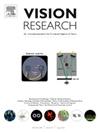探索后像外观与自然色彩系统
IF 1.4
4区 心理学
Q4 NEUROSCIENCES
引用次数: 0
摘要
彩色后像是在观看空白背景时,在该区域呈现诱导性或适应性色彩刺激一段时间后,在视野中感知到的色调。彩色残像体验是由物理刺激引发的,但即使没有这种刺激也会持续存在。这是一种私人的感知体验,但它仍然是科学研究的一个重要焦点。彩色后像的研究通常集中在后像的外观上,并且已经开发了各种测量后像外观的方法。本研究采用直接外观匹配和直观的颜色外观系统来有效地探索后像外观。作者采用自然色系统(NCS)作为测量和表示后像颜色外观的参考系统。诱导刺激由根据NCS符号选择的具有不同色调和细微差别(黑度和色度)的色块组成,而诱导后像的色调是通过将感知到的后像与由40个色块组成的色圈进行匹配来确定的。这40个补丁是从标准的40种NCS色调中选择的,在初始阶段都具有相同的细微差别值。在为给定的诱导斑块建立色相后,第二阶段的匹配任务利用一组色度降低的斑块来实现细微差别匹配。将收集到的数据用于在NCS色彩空间中构建彩色后像映射,在构建良好的色彩空间中为彩色后像及其诱导颜色提供经验指导。本文章由计算机程序翻译,如有差异,请以英文原文为准。
Exploring afterimage appearance with the natural color system
A color afterimage is the perceived hue in the visual field when viewing a blank background after an inducing or adapting chromatic stimulus has been presented in that area for a certain duration. Color afterimage experiences are triggered by physical stimuli but persist even without such stimuli. It is a private perceptual experience, yet it remains a significant focus of scientific investigations. Research on color afterimages usually focuses on the appearance of these afterimages, and various methods for measuring their appearance have been developed. The present study employs direct appearance matching and an intuitive color appearance system to explore afterimage appearances effectively. The authors adopted the Natural Color System (NCS) as the reference system for measuring and representing the color appearance of afterimages. The inducing stimuli consisted of selected color patches with various hues and nuances (blackness and chromaticness) according to the NCS notations, while the induced afterimage hues were determined by matching the perceived afterimages to a color circle comprised of 40 patches. These 40 patches were chosen from the standard 40 NCS hues, all with the same nuance value in the initial phase. After establishing the hue for a given induced patch, a second-stage matching task utilized a set of patches with reduced chromaticness to achieve a nuance match. The collected data were used to construct a color afterimage map in the NCS color space, providing empirical guidelines about color afterimages and their inducing colors within a well-constructed color space.
求助全文
通过发布文献求助,成功后即可免费获取论文全文。
去求助
来源期刊

Vision Research
医学-神经科学
CiteScore
3.70
自引率
16.70%
发文量
111
审稿时长
66 days
期刊介绍:
Vision Research is a journal devoted to the functional aspects of human, vertebrate and invertebrate vision and publishes experimental and observational studies, reviews, and theoretical and computational analyses. Vision Research also publishes clinical studies relevant to normal visual function and basic research relevant to visual dysfunction or its clinical investigation. Functional aspects of vision is interpreted broadly, ranging from molecular and cellular function to perception and behavior. Detailed descriptions are encouraged but enough introductory background should be included for non-specialists. Theoretical and computational papers should give a sense of order to the facts or point to new verifiable observations. Papers dealing with questions in the history of vision science should stress the development of ideas in the field.
 求助内容:
求助内容: 应助结果提醒方式:
应助结果提醒方式:


